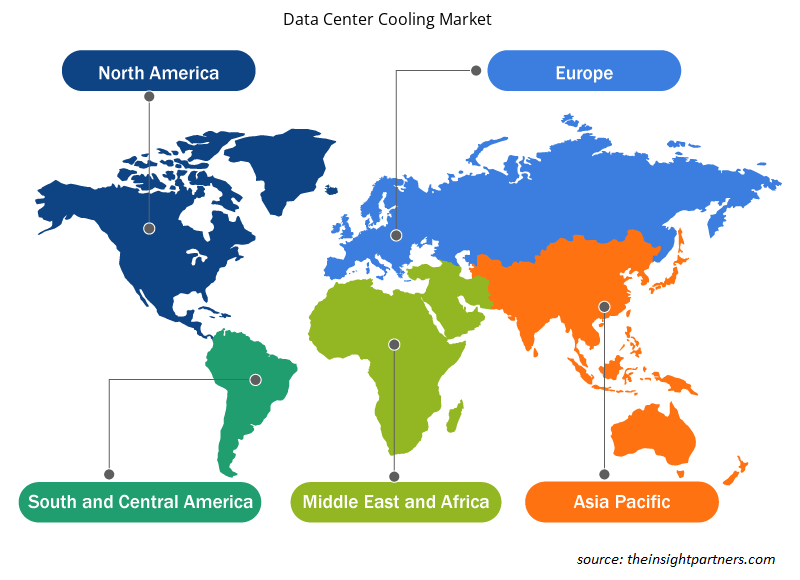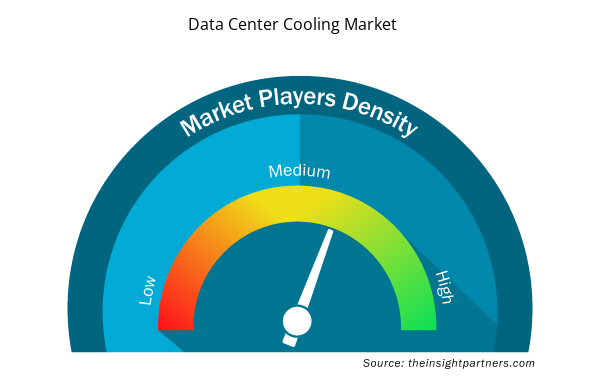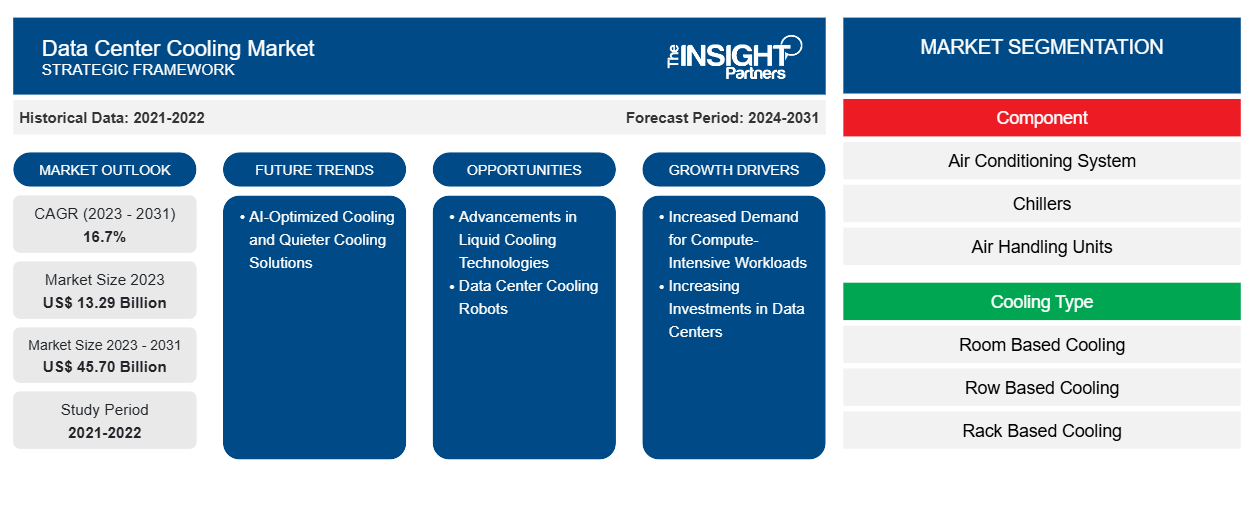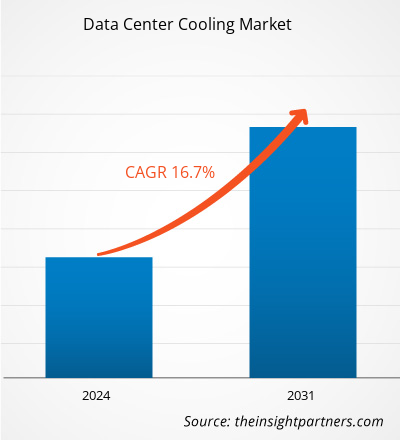من المتوقع أن يصل حجم سوق تبريد مراكز البيانات إلى 45.70 مليار دولار أمريكي بحلول عام 2031 من 13.29 مليار دولار أمريكي في عام 2023. ومن المتوقع أن يسجل السوق معدل نمو سنوي مركب بنسبة 16.7٪ خلال الفترة 2023-2031. ومن المرجح أن تجلب حلول التبريد المحسّنة بالذكاء الاصطناعي والتبريد الأكثر هدوءًا اتجاهات جديدة إلى السوق.
تحليل سوق تبريد مراكز البيانات
إن الطلب المتزايد على أحمال العمل كثيفة الحوسبة والاستثمارات الكبيرة في مراكز البيانات تدفع سوق تبريد مراكز البيانات . كما يشهد السوق أيضًا استخدامًا أكبر للحوسبة عالية الأداء (HPC)، مما يساهم في الطلب على حلول تبريد مراكز البيانات. علاوة على ذلك، تساهم المبادرات الاستراتيجية المتزايدة التي اتخذتها الشركات الكبرى، مثل التعاون بين شركة Intel Corporation و Submer لتطوير حل لرقائق التبريد ذات الطاقة الحرارية التصميمية العالية (TDP)، في نمو السوق. علاوة على ذلك، من المتوقع أن تعمل الحاجة المتزايدة إلى حلول تبريد مراكز البيانات الموفرة للطاقة والقوية، إلى جانب الانتشار المتزايد للإنترنت؛ والحوسبة السحابية؛ وتقنيات مثل الذكاء الاصطناعي، وإنترنت الأشياء، والبيانات الضخمة، على تغذية اعتماد تبريد السائل في مراكز البيانات. ومن المتوقع أن ينمو السوق في الفترة المتوقعة بسبب التقدم في تقنيات التبريد السائل وارتفاع روبوتات تبريد مراكز البيانات.
نظرة عامة على سوق تبريد مراكز البيانات
يشير تبريد مركز البيانات إلى الأنظمة والتقنيات المستخدمة للحفاظ على درجة حرارة مثالية داخل مركز البيانات لضمان الأداء السليم لمعدات تكنولوجيا المعلومات. تنتج معدات تكنولوجيا المعلومات حرارة أثناء التشغيل، ويمكن أن تؤدي الحرارة الشديدة إلى تعطل المعدات وفشلها. للتغلب على مثل هذه التحديات، زاد الطلب على تبريد مركز البيانات بسرعة. تعد أنظمة التبريد ضرورية للحفاظ على موثوقية وأداء البنية التحتية لمركز البيانات. يلعب تبريد مركز البيانات دورًا حيويًا في إنشاء واستدامة الظروف التشغيلية المثلى لجميع المعدات الموجودة داخل مركز البيانات. تستهلك مراكز البيانات مجتمعة ما يقرب من 3٪ من كهرباء العالم؛ ونتيجة لذلك، يتم توليد كمية كبيرة من الحرارة. بدون تنفيذ نظام تبريد فعال، يزداد خطر تعطل معدات تكنولوجيا المعلومات والأضرار المكلفة وتوقف التشغيل بشكل كبير.
قم بتخصيص هذا التقرير ليناسب متطلباتك
ستحصل على تخصيص لأي تقرير - مجانًا - بما في ذلك أجزاء من هذا التقرير، أو تحليل على مستوى الدولة، وحزمة بيانات Excel، بالإضافة إلى الاستفادة من العروض والخصومات الرائعة للشركات الناشئة والجامعات
- احصل على أهم اتجاهات السوق الرئيسية لهذا التقرير.ستتضمن هذه العينة المجانية تحليلاً للبيانات، بدءًا من اتجاهات السوق وحتى التقديرات والتوقعات.
محركات وفرص سوق تبريد مراكز البيانات
تزايد الطلب على أحمال العمل التي تتطلب قدرًا كبيرًا من الحوسبة لتعزيز نمو السوق
تدمج العديد من الصناعات الذكاء الاصطناعي والتعلم الآلي لتحسين تجربة العملاء، وتعزيز تدابير الأمن السيبراني، وإحداث ثورة في عمليات الأعمال الخاصة بها. يتطلب نشر هذه التقنيات وتحسين قيمتها بنية تحتية قوية قادرة على التعامل مع أحمال العمل المعقدة بشكل متزايد. دفعت طبيعة تدريب نموذج الذكاء الاصطناعي المكثفة الحوسبة إلى تطور الأجهزة لتلبية المطالب المتزايدة للذكاء الاصطناعي والتطبيقات المتقدمة الأخرى. على سبيل المثال، في أبريل 2024، أعلنت لينوفو عن مجموعة شاملة جديدة من أنظمة وحلول البنية التحتية المبنية خصيصًا والمرتكزة على الذكاء الاصطناعي لتعزيز ابتكار الذكاء الاصطناعي الهجين من الحافة إلى السحابة. تقدم لينوفو حلولاً غنية بوحدات معالجة الرسوميات وفعالة حرارياً مخصصة لأحمال العمل كثيفة الحوسبة عبر بيئات وصناعات متعددة. في صناعات الخدمات المالية والرعاية الصحية، يدير العملاء مجموعات بيانات ضخمة تتطلب نطاق ترددي للإدخال والإخراج الشديد، وتوفر لينوفو حلول البنية التحتية لتكنولوجيا المعلومات الحيوية لإدارة البيانات المهمة.
مع استمرار الشركات في تسخير إمكانات الذكاء الاصطناعي والتعلم الآلي ، يلعب التطور المستمر لأجهزة الحوسبة دورًا محوريًا في تمكين المعالجة والاستخدام الفعالين لكميات هائلة من البيانات، وبالتالي تمكين المؤسسات من اتخاذ قرارات مستنيرة وتحليل أصول البيانات. أدت زيادة سعة الحوسبة والطلب على الأجهزة إلى زيادة استهلاك الطاقة وتوليد الحرارة. ونتيجة لذلك، سلطت درجات حرارة مراكز البيانات المرتفعة، المنسوبة إلى استخدام أجهزة ذات كثافة أعلى، الضوء على أهمية التبريد السائل كتكنولوجيا حاسمة للتخفيف من هذه التحديات الحرارية. وبالتالي، فإن الطلب المتزايد على أحمال العمل كثيفة الحوسبة يحرك سوق تبريد مراكز البيانات.
التطورات في تكنولوجيا التبريد السائل
برز التبريد السائل كحل مثالي لتلبية متطلبات صناعات الحوسبة عالية الأداء ومراكز البيانات. من خلال إلغاء ضرورة دوران الهواء المستمر، يقلل التبريد السائل بشكل ملحوظ من استهلاك المرافق، وبالتالي يعزز كفاءة الطاقة في المنشأة. ظهرت تقنيات التبريد السائل كحل شائع، حيث تستخدمها حوالي 40٪ من مراكز البيانات. تشكل الشركات شراكات استراتيجية للمشاركة في تقدم تقنيات التبريد السائل. على سبيل المثال، شكلت شركة ميتسوبيشي للصناعات الثقيلة المحدودة (MHI) وشركة ZutaCore، Inc. شراكة استراتيجية في سبتمبر 2023 لتطوير حلول التبريد السائل المستدامة لصناعة البيانات لتحقيق كفاءة الطاقة والانبعاثات الصفرية. يتضمن هذا التعاون استثمار MHI في ZutaCore واتفاقية مبيعات العلامة البيضاء، والجمع بين تقنية التبريد السائل المباشر العازل HyperCool من ZutaCore مع خط منتجات MHI الواسع والخبرة التكنولوجية على نطاق عالمي. تعد تقنية HyperCool من ZutaCore حل تبريد سائل مباشر على الشريحة بدون ماء يهدف إلى سد الفجوة بين استدامة صناعة البيانات وقوة الحوسبة المتزايدة باستمرار. إنها توفر حوسبة أكبر بمقدار 10 أضعاف، وتخفيضًا بنسبة 50% في إجمالي تكلفة الملكية (TCO)، وإعادة استخدام الحرارة بنسبة 100%، فضلاً عن تقليل انبعاثات ثاني أكسيد الكربون. تم تصميم هذه التقنية لنقل كميات كبيرة من الحرارة بعيدًا عن الشريحة بشكل فعال وآمن، دون وجود حد عملي لتبديد الحرارة. كما تهدف إلى تقليل استهلاك الموارد النادرة، بما في ذلك الطاقة والمياه والأرض، مع تقليل رأس المال ونفقات التشغيل. تهدف هذه الشراكة إلى تسريع نمو حلول التبريد السائل المستدامة التي تعد ضرورية لكفاءة الطاقة. يوفر الحل الشامل الذي توفره هذه الشراكة فوائد غير مسبوقة لأحمال عمل الحوسبة عالية الأداء، وتكثيف الخوادم، واستدامة مراكز البيانات.
تقرير تحليل تجزئة سوق تبريد مراكز البيانات
كانت القطاعات الرئيسية التي ساهمت في اشتقاق تحليل سوق تبريد مركز البيانات هي المكون ونوع التبريد ونوع مركز البيانات والقطاع الرأسي.
- من حيث المكونات، يتم تقسيم السوق إلى مبردات وأنظمة تكييف الهواء والمبادلات الحرارية وأبراج التبريد ووحدات معالجة الهواء وأجهزة الترطيب وغيرها. سيطر قطاع أنظمة تكييف الهواء على السوق في عام 2023.
- بحسب نوع التبريد، يتم تصنيف السوق إلى تبريد قائم على الغرفة وتبريد قائم على الرف وتبريد قائم على الصف. وقد هيمنت شريحة التبريد القائم على الغرفة على السوق في عام 2023.
- بناءً على نوع مركز البيانات، يتم تقسيم سوق تبريد مركز البيانات إلى مركز بيانات مؤسسي ومركز بيانات مشترك ومركز بيانات بالجملة ومركز بيانات ضخم. سيطر قطاع مراكز البيانات الضخمة على السوق في عام 2023.
- من حيث الصناعة العمودية، يتم تصنيف السوق إلى BFSI، التصنيع، تكنولوجيا المعلومات والاتصالات، وسائل الإعلام والترفيه، التجزئة، الحكومة والدفاع، الرعاية الصحية، الطاقة، وغيرها. هيمن قطاع تكنولوجيا المعلومات والاتصالات على السوق في عام 2023.
تحليل حصة سوق تبريد مراكز البيانات حسب المنطقة الجغرافية
تم تقسيم سوق تبريد مراكز البيانات إلى خمس مناطق رئيسية: أمريكا الشمالية وأوروبا وآسيا والمحيط الهادئ (APAC) والشرق الأوسط وأفريقيا (MEA) وأمريكا الجنوبية والوسطى. سيطرت أمريكا الشمالية على السوق في عام 2023، تليها أوروبا ومنطقة آسيا والمحيط الهادئ.
يشهد سوق تبريد مراكز البيانات في أمريكا الشمالية نموًا كبيرًا بسبب ارتفاع صناعة مراكز البيانات والاعتماد المتزايد على حلول تبريد مراكز البيانات الفعالة من حيث التكلفة والصديقة للبيئة. يقدم اللاعبون في السوق حلولاً مبتكرة ومتقدمة لتلبية الطلب على حلول الحوسبة المتقدمة تقنيًا، مما يزيد من نمو السوق. على سبيل المثال، في نوفمبر 2023، قدمت Vertiv Vertiv SmartMod Max CW، وهو مركز بيانات معياري مسبق الصنع تم بناؤه لتلبية الطلب المتزايد على النشر السريع للحوسبة في أمريكا الشمالية.
رؤى إقليمية حول سوق تبريد مراكز البيانات
لقد قام المحللون في Insight Partners بشرح الاتجاهات والعوامل الإقليمية المؤثرة على سوق تبريد مراكز البيانات طوال فترة التوقعات بشكل شامل. يناقش هذا القسم أيضًا قطاعات سوق تبريد مراكز البيانات والجغرافيا في جميع أنحاء أمريكا الشمالية وأوروبا ومنطقة آسيا والمحيط الهادئ والشرق الأوسط وأفريقيا وأمريكا الجنوبية والوسطى.

- احصل على البيانات الإقليمية المحددة لسوق تبريد مراكز البيانات
نطاق تقرير سوق تبريد مراكز البيانات
| سمة التقرير | تفاصيل |
|---|---|
| حجم السوق في عام 2023 | 13.29 مليار دولار أمريكي |
| حجم السوق بحلول عام 2031 | 45.70 مليار دولار أمريكي |
| معدل النمو السنوي المركب العالمي (2023 - 2031) | 16.7% |
| البيانات التاريخية | 2021-2022 |
| فترة التنبؤ | 2024-2031 |
| القطاعات المغطاة | حسب المكون
|
| المناطق والدول المغطاة | أمريكا الشمالية
|
| قادة السوق وملفات تعريف الشركات الرئيسية |
|
كثافة اللاعبين في سوق تبريد مراكز البيانات: فهم تأثيرها على ديناميكيات الأعمال
يشهد سوق تبريد مراكز البيانات نموًا سريعًا، مدفوعًا بالطلب المتزايد من المستخدم النهائي بسبب عوامل مثل تفضيلات المستهلكين المتطورة والتقدم التكنولوجي والوعي المتزايد بفوائد المنتج. ومع ارتفاع الطلب، تعمل الشركات على توسيع عروضها والابتكار لتلبية احتياجات المستهلكين والاستفادة من الاتجاهات الناشئة، مما يؤدي إلى زيادة نمو السوق.
تشير كثافة اللاعبين في السوق إلى توزيع الشركات أو المؤسسات العاملة في سوق أو صناعة معينة. وهي تشير إلى عدد المنافسين (اللاعبين في السوق) الموجودين في مساحة سوق معينة نسبة إلى حجمها أو قيمتها السوقية الإجمالية.
الشركات الرئيسية العاملة في سوق تبريد مركز البيانات هي:
- شركة أسيتيك
- فوجيتسو المحدودة
- شركة ميتسوبيشي
- شركة ريتال المحدودة وشركاه
- شركة شنايدر الكتريك
- شركة ستولز
إخلاء المسؤولية : الشركات المذكورة أعلاه ليست مرتبة بأي ترتيب معين.

- احصل على نظرة عامة على أهم اللاعبين الرئيسيين في سوق تبريد مركز البيانات
أخبار سوق تبريد مراكز البيانات والتطورات الأخيرة
يتم تقييم سوق تبريد مراكز البيانات من خلال جمع البيانات النوعية والكمية بعد البحث الأولي والثانوي، والذي يتضمن منشورات الشركات المهمة وبيانات الجمعيات وقواعد البيانات. فيما يلي بعض التطورات في سوق تبريد مراكز البيانات:
- طورت شركة ميتسوبيشي للصناعات الثقيلة المحدودة (MHI) مركز بيانات جديدًا من نوع الحاوية 12 قدمًا من فئة 40 كيلو فولت أمبير مع نظام تبريد هجين بالغمر/التبريد بالهواء قادر على إيواء خوادم في وقت واحد باستخدام ثلاثة أنواع من طرق التبريد: التبريد بالغمر (25 كيلو فولت أمبير)، والتبريد بالهواء (8 كيلو فولت أمبير)، والتبريد المائي (8 كيلو فولت أمبير). كان مركز البيانات المطوَّر حديثًا هو خليفة مركز البيانات بالتبريد بالغمر من نوع الحاوية الذي كان قيد التطوير منذ عام 2021. يمكن تركيب خوادم بطرق تبريد مختلفة لمجموعة متنوعة من التطبيقات (حسب كثافة الطاقة) في الوحدة في وقت واحد، واستيعاب مجموعة متنوعة من الخوادم والأجهزة الأخرى للحوسبة الطرفية لمعالجة البيانات على محيط (حافة) شبكات الكمبيوتر.
(المصدر: شركة ميتسوبيشي للصناعات الثقيلة المحدودة، بيان صحفي، أكتوبر 2023)
- أعلنت شركة STULZ، المتخصصة العالمية في أنظمة تكييف الهواء ذات الأهمية الحرجة، عن إطلاق CyberCool CMU - وحدة جديدة مبتكرة لإدارة وتوزيع سائل التبريد (CDU) مصممة لتحقيق أقصى قدر من كفاءة تبادل الحرارة في حلول التبريد السائل.
(المصدر: STULZ، بيان صحفي، مارس 2024)
تغطية تقرير سوق تبريد مراكز البيانات والمنتجات النهائية
يوفر "حجم سوق تبريد مراكز البيانات والتوقعات (2021-2031)" تحليلاً مفصلاً للسوق يغطي المجالات المذكورة أدناه:
- حجم سوق تبريد مراكز البيانات وتوقعاته على المستويات العالمية والإقليمية والوطنية لجميع قطاعات السوق الرئيسية التي يغطيها النطاق
- اتجاهات سوق تبريد مراكز البيانات بالإضافة إلى ديناميكيات السوق مثل المحركات والقيود والفرص الرئيسية
- تحليل مفصل لـ PEST و SWOT
- تحليل سوق تبريد مراكز البيانات يغطي اتجاهات السوق الرئيسية والإطار العالمي والإقليمي واللاعبين الرئيسيين واللوائح والتطورات الأخيرة في السوق
- تحليل المشهد الصناعي والمنافسة الذي يغطي تركيز السوق، وتحليل خريطة الحرارة، واللاعبين البارزين، والتطورات الأخيرة لسوق تبريد مراكز البيانات
- ملفات تعريف الشركة التفصيلية
- التحليل التاريخي (سنتان)، السنة الأساسية، التوقعات (7 سنوات) مع معدل النمو السنوي المركب
- تحليل PEST و SWOT
- حجم السوق والقيمة / الحجم - عالميًا وإقليميًا وقطريًا
- الصناعة والمنافسة
- مجموعة بيانات Excel



Report Coverage
Revenue forecast, Company Analysis, Industry landscape, Growth factors, and Trends

Segment Covered
This text is related
to segments covered.

Regional Scope
North America, Europe, Asia Pacific, Middle East & Africa, South & Central America

Country Scope
This text is related
to country scope.
الأسئلة الشائعة
Increasing demand for compute-intensive workloads and rising investments in data centers are the driving factors impacting the data center cooling market.
AI-optimized cooling and quieter cooling solutions is the future trends of the data center cooling market.
The key players, holding majority shares, in data center cooling market includes Vertiv Group Corp, Schneider Electric, Mitsubishi Electric Corporation, FUJITSU, and STULZ Air Technology Systems, Inc.
Asia Pacific is anticipated to grow with the highest CAGR over the forecast period 2024-2031.
The North America held the largest market share in 2023, followed by Europe.
The data center cooling market was valued at US$ 13.29 billion in 2023 and is projected to reach US$ 45.70 billion by 2031; it is expected to grow at a CAGR of 16.7% during 2023–2031.
The List of Companies - Data Center Cooling Market
- Asetek, Inc
- Fujitsu Ltd
- Mitsubishi Corp
- Rittal GmbH & Co KG
- Schneider Electric SE
- Stulz SpA
- Trane Technologies Plc
- Vertiv Group Corp.
- Black Box Corporation
- Carrier Global Corp
- Aspen Systems, LLC.
- Daikin Industries Ltd
- Delta Electronics Inc
- Danfoss AS
- Alfa Laval AB
- Hewlett Packard Enterprise Development LP
- Boyd Corp
- Evapco Inc
- Motivair Corporation
- Madison Industries
The Insight Partners performs research in 4 major stages: Data Collection & Secondary Research, Primary Research, Data Analysis and Data Triangulation & Final Review.
- Data Collection and Secondary Research:
As a market research and consulting firm operating from a decade, we have published and advised several client across the globe. First step for any study will start with an assessment of currently available data and insights from existing reports. Further, historical and current market information is collected from Investor Presentations, Annual Reports, SEC Filings, etc., and other information related to company’s performance and market positioning are gathered from Paid Databases (Factiva, Hoovers, and Reuters) and various other publications available in public domain.
Several associations trade associates, technical forums, institutes, societies and organization are accessed to gain technical as well as market related insights through their publications such as research papers, blogs and press releases related to the studies are referred to get cues about the market. Further, white papers, journals, magazines, and other news articles published in last 3 years are scrutinized and analyzed to understand the current market trends.
- Primary Research:
The primarily interview analysis comprise of data obtained from industry participants interview and answers to survey questions gathered by in-house primary team.
For primary research, interviews are conducted with industry experts/CEOs/Marketing Managers/VPs/Subject Matter Experts from both demand and supply side to get a 360-degree view of the market. The primary team conducts several interviews based on the complexity of the markets to understand the various market trends and dynamics which makes research more credible and precise.
A typical research interview fulfils the following functions:
- Provides first-hand information on the market size, market trends, growth trends, competitive landscape, and outlook
- Validates and strengthens in-house secondary research findings
- Develops the analysis team’s expertise and market understanding
Primary research involves email interactions and telephone interviews for each market, category, segment, and sub-segment across geographies. The participants who typically take part in such a process include, but are not limited to:
- Industry participants: VPs, business development managers, market intelligence managers and national sales managers
- Outside experts: Valuation experts, research analysts and key opinion leaders specializing in the electronics and semiconductor industry.
Below is the breakup of our primary respondents by company, designation, and region:

Once we receive the confirmation from primary research sources or primary respondents, we finalize the base year market estimation and forecast the data as per the macroeconomic and microeconomic factors assessed during data collection.
- Data Analysis:
Once data is validated through both secondary as well as primary respondents, we finalize the market estimations by hypothesis formulation and factor analysis at regional and country level.
- Macro-Economic Factor Analysis:
We analyse macroeconomic indicators such the gross domestic product (GDP), increase in the demand for goods and services across industries, technological advancement, regional economic growth, governmental policies, the influence of COVID-19, PEST analysis, and other aspects. This analysis aids in setting benchmarks for various nations/regions and approximating market splits. Additionally, the general trend of the aforementioned components aid in determining the market's development possibilities.
- Country Level Data:
Various factors that are especially aligned to the country are taken into account to determine the market size for a certain area and country, including the presence of vendors, such as headquarters and offices, the country's GDP, demand patterns, and industry growth. To comprehend the market dynamics for the nation, a number of growth variables, inhibitors, application areas, and current market trends are researched. The aforementioned elements aid in determining the country's overall market's growth potential.
- Company Profile:
The “Table of Contents” is formulated by listing and analyzing more than 25 - 30 companies operating in the market ecosystem across geographies. However, we profile only 10 companies as a standard practice in our syndicate reports. These 10 companies comprise leading, emerging, and regional players. Nonetheless, our analysis is not restricted to the 10 listed companies, we also analyze other companies present in the market to develop a holistic view and understand the prevailing trends. The “Company Profiles” section in the report covers key facts, business description, products & services, financial information, SWOT analysis, and key developments. The financial information presented is extracted from the annual reports and official documents of the publicly listed companies. Upon collecting the information for the sections of respective companies, we verify them via various primary sources and then compile the data in respective company profiles. The company level information helps us in deriving the base number as well as in forecasting the market size.
- Developing Base Number:
Aggregation of sales statistics (2020-2022) and macro-economic factor, and other secondary and primary research insights are utilized to arrive at base number and related market shares for 2022. The data gaps are identified in this step and relevant market data is analyzed, collected from paid primary interviews or databases. On finalizing the base year market size, forecasts are developed on the basis of macro-economic, industry and market growth factors and company level analysis.
- Data Triangulation and Final Review:
The market findings and base year market size calculations are validated from supply as well as demand side. Demand side validations are based on macro-economic factor analysis and benchmarks for respective regions and countries. In case of supply side validations, revenues of major companies are estimated (in case not available) based on industry benchmark, approximate number of employees, product portfolio, and primary interviews revenues are gathered. Further revenue from target product/service segment is assessed to avoid overshooting of market statistics. In case of heavy deviations between supply and demand side values, all thes steps are repeated to achieve synchronization.
We follow an iterative model, wherein we share our research findings with Subject Matter Experts (SME’s) and Key Opinion Leaders (KOLs) until consensus view of the market is not formulated – this model negates any drastic deviation in the opinions of experts. Only validated and universally acceptable research findings are quoted in our reports.
We have important check points that we use to validate our research findings – which we call – data triangulation, where we validate the information, we generate from secondary sources with primary interviews and then we re-validate with our internal data bases and Subject matter experts. This comprehensive model enables us to deliver high quality, reliable data in shortest possible time.


 احصل على عينة مجانية لهذا التقرير
احصل على عينة مجانية لهذا التقرير